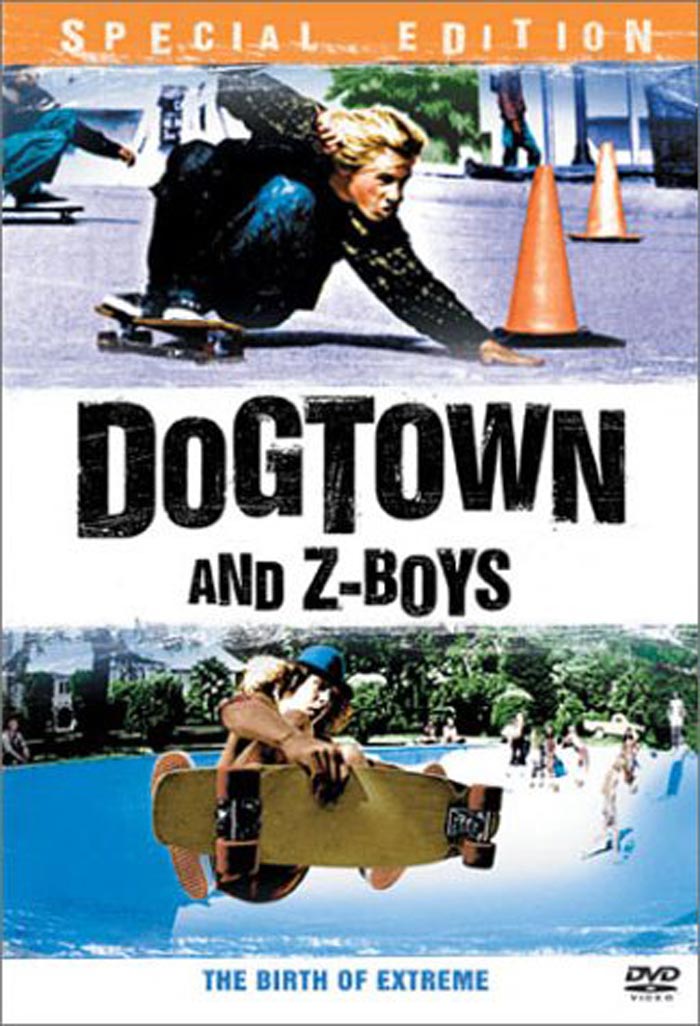
[Review copy provided by PR firm.]
When I was asked if I’d be interested in reviewing Dogtown and Z-Boys, I thought to myself, “Sure. I don’t know anything about skateboarding, but it looks interesting.”
I was in for a surprise. And apparently, I wasn’t the only one.
This documentary, directed by Stacy Peralta, edited by Paul Crowder and narrated by Sean Penn, cleaned up on the film festival circuit with wins at the Independent Spirit Awards, the Sundance Film Festival and the AFI Film Festival.
How does a documentary win audience-favorite awards? Subject matter and style.
Dogtown and Z-Boys records the grassroots rise and birth of modern skateboarding. While today’s kids are inspired by Tony Hawk, these guys (and a gal) were the ones who inspired Hawk and the cadre of pro and recreational skateboarders that followed.
Known as “Z-Boys,” these Venice, California teens were part of a neighborhood foster family that sprung up around the Jeff Ho & Zephyr Production Surf Shop, located in a rundown beachside area known as “Dogtown.” As junior members of the shop’s surf team, they trained on skateboards when there were no waves suitable for surfing.
Skateboarding was a secondary activity. By the 1970s, the sport, which had its shining moment of popularity in the 1960s, was considered passé. The turning point came when an advance in wheel technology led to its resurgence and allowed those few still “surfing the street” the ability to go faster, farther and smoother.
At the 1975 Bahne-Cadillac Skateboard Championship, the Zephyr Skating Team made its public debut, and its working-class kids turned the sport on its ear by performing surf-inspired moves unlike anything else anyone else was doing at the time.
Members of the Zephyr team became overnight superstars for something they never imagined would bring them notoriety. They were the first to have fans and sponsors. They were the first to execute the vertical, aerial maneuvers that are the foundation for what you see at today’s competitions. Their lifestyles, documented by Zephyr co-owner/photographer/writer Craig Stecyk, were publicized in an unprecedented way that revolutionized how youth and nontraditional sports are viewed, both within their niche and by the public at-large.
Peralta is uniquely qualified for his directorial duties: He was, perhaps, the most commercially successful alumnus of the Zephyr team, and he has been involved with filmmaking since the BONES Brigade skate videos of the 1980s. His involvement, along with that of Crowder, lends the film a rough, rock’n’roll feel. It is an intricate and effective composition, interspersing recent interviews with vintage Super-8 footage and stills to recreate the motion of the sport. Instead of recounting skateboarding’s rebirth chronologically, they focus on the first-person accounts of the individuals behind its explosion, including Tony Alva, Jay Adams and Peralta.
Dogtown and Z-Boys conveys what it meant to be there. After all, being there — with style and the athleticism to back it up — was what it was, and still is, all about.
More Info:
DOGTOWN AND Z-BOYS DVD Special Features
– Digitally Mastered Audio and Anamorphic Video
– Audio: English 5.0 (Dolby Digital), French
– Subtitles: English, French
– Director and Editor Commentary: Extremely informative, includes insight from the time, as well as behind-the-scenes details as to how the film was assembled. If you’re a film/editing student, listen up!
– Extended “Raw” Skate Footage: Hit a button when cued to see the raw footage that was excerpted in the film segments of the finished documentary.
– Theatrical Trailers
– Weblinks
– Scene Selections
– Interactive Menus
DOGTOWN AND Z-BOYS Rated PG-13 for language and drug references.
© 2002 Vans, Inc. / Sony Pictures Classics / Columbia TriStar Home Entertainment. All rights reserved.